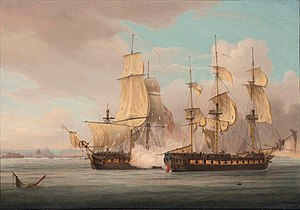 HMS Crescent battles La Réunion off the Cotentin Peninsula, on 20 October 1793. Thomas Whitcombe
| |
| History | |
|---|---|
| Name | HMS Crescent |
| Ordered | 11 August 1781 |
| Builder | John Nowlan and Thomas Calhoun, Bursledon |
| Laid down | November 1781 |
| Launched | 28 October 1784 |
| Commissioned | May 1790 |
| Fate | Wrecked on 6 December 1808 |
| General characteristics As built | |
| Class and type | Flora-Class (36-gun frigate) |
| Tons burthen | 88785⁄94 (bm) |
| Length | 137 feet 2+1⁄2 inches (41.821 m) (overall) |
| Beam | 38 feet 5+1⁄25 inches (11.710 m) |
| Depth | 13 feet 3+1⁄2 inches (4.051 m) |
| Propulsion | Sails |
| Sail plan | Full-rigged ship |
| Armament |
|
HMS Crescent was a 36-gun Flora-class frigate of the British Royal Navy. Launched in 1784, she spent the first years of her service on blockade duty in the English Channel where she single-handedly captured the French frigate, La Reunion. In 1795, Crescent was part of a squadron commanded by George Elphinstone, that forced the surrender of a Batavian Navy squadron at the capitulation of Saldanha Bay. After serving in the West Indies, Crescent returned to home waters and was wrecked off the coast of Jutland on 6 December 1808.